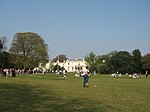Church of All Hallows, Allerton
19th-century Church of England church buildingsAnglican Diocese of LiverpoolBuildings by Grayson and OuldChurch of England church buildings in MerseysideChurches completed in 1876 ... and 6 more
Churches in LiverpoolGothic Revival architecture in MerseysideGothic Revival church buildings in EnglandGrade I listed buildings in LiverpoolGrade I listed churches in MerseysideUse British English from April 2014

The Church of All Hallows is in Allerton, Liverpool, England. It is recorded in the National Heritage List for England as a designated Grade I listed building, and is an active Anglican parish church in the diocese of Liverpool, the archdeaconry of Liverpool and the deanery of Liverpool South – Childwall.
Excerpt from the Wikipedia article Church of All Hallows, Allerton (License: CC BY-SA 3.0, Authors, Images).Church of All Hallows, Allerton
Greenhill Road, Liverpool Allerton
Geographical coordinates (GPS) Address External links Nearby Places Show on map
Geographical coordinates (GPS)
| Latitude | Longitude |
|---|---|
| N 53.3807 ° | E -2.9035 ° |
Address
All Hallows Church
Greenhill Road
L18 6JJ Liverpool, Allerton
England, United Kingdom
Open on Google Maps








